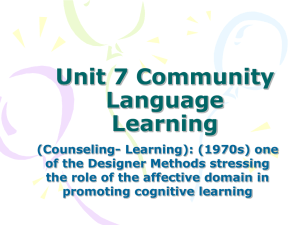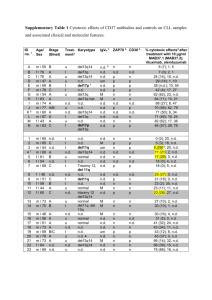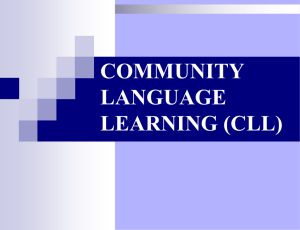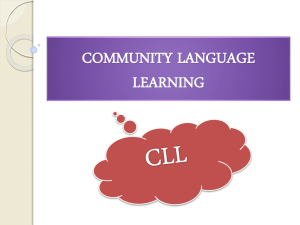Community Language Learning (CLL) Presentation
advertisement
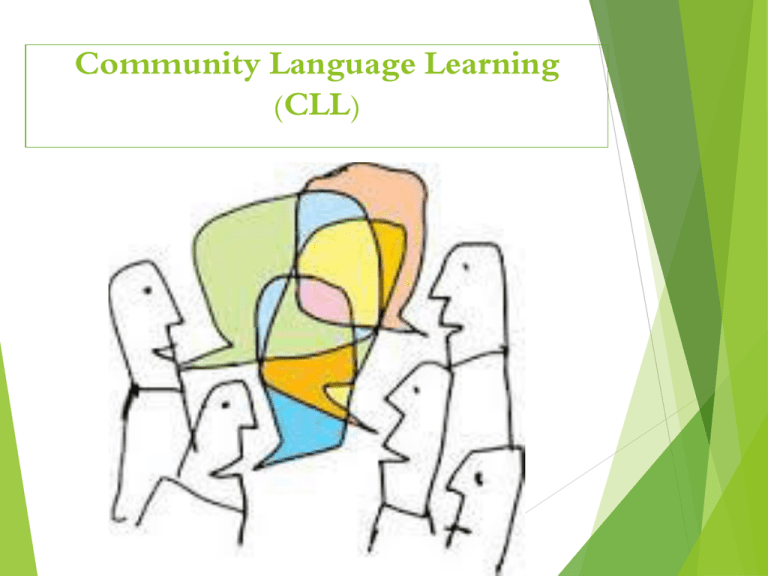
Community Language Learning (CLL) By the end of this lecture, students should be able to: Develop an awareness about the history of CLL. Recognize the nature of CLL. Define CLL. Recognize the methodology of CLL. Identify the advantages and disadvantages of CLL. Form an outline about CLL. Objectives of this lecture The History of the Community Language Learning Community Language Learning (CLL)was developed by Charles Curran and his associates. Curran was a specialist in counseling and a professor of psychology. His application of psychological counseling techniques to learning is known as Counseling-Learning. CLL represents the use of Counseling-Learning theory to teach languages. Consequently, the learner is not thought of as a student but as a client. The instructors of the language are not considered teachers but, rather are trained in counseling skills adapted to their roles as language counselors. The nature of Community Language Learning (1) Students are to be considered as "learner-clients" and the teacher as a "teacher-counselor". (2) A relationship of mutual trust and support is considered essential to the learning process. (3) Students are permitted to use their native language, and are provided with translations from the teacher which they then attempt to apply. (4) Grammar and vocabulary are taught inductively. (5) "Chunks" of target language produced by the students are recorded and later listened to they are also transcribed with native language equivalents to become texts the students work with. The nature of Community Language Learning 6) Students apply the target language independently and without translation when they feel inclined/ confident enough to do so. (7) Students are encouraged to express not only how they feel about the language, but how they feel about the learning process, to which the teacher expresses empathy and understanding. (8) CLL is a good method for beginners who just first study their second language. Using this method can help beginners to reduce their anxiety in the classroom. (9) This method considers the student to be “whole person”. It is not only to think about students’ intellect but also their feeling in learning language. (10) students (8 to 12 maximum) sit in a circle. The teacher (who is termed the ‘Counselor’ ) stands outside the circle, and only help when needed by students. Definition of Community Language Learning: CLL) is an approach in which students and teacher work together to develop the aspects of a language they would like to learn. The teacher acts as a counselor, while the learner acts as a kind of patient being guided through established stages of development. There are 5 main stages in CLL: • Birth stage: a feeling of security and belonging is established • As the learner's abilities improve, a measure of independence is achieved • Learners start to speak independently • The learners are secure enough to take criticism and correction • The child becomes an "adult" and becomes proficient in the language The Methodology of CLL: STAGE 1 The client is completely dependent on the language counselor. First, the S expresses only to the counselor in L1 what he wishes to say to the group. The counselor then reflects these ideas back to the client in the L2. The client turns to the group and presents his idea in foreign language. Stage 2 With a lot of practice, the client speaks directly to the group in the foreign language, and the group has now acquired the ability to understand his simple phrases. This presumes the client’s greater confidence, independence, and proportionate insight into the relationship of phrases, grammar, and ideas. Translation is given only when a group member desires it. Stage 3 The client is now speaking freely and complexly in the foreign language. He/she presumes group’s understanding. The counselor directly intervenes in grammatical error, mispronunciation, or where aid in complex expression is needed. The client is sufficiently secure to take correction. Stage 4 The counselor intervenes not only to offer correction but to add idioms and more elegant constructions. At this stage the client can become counselor to the group Advantages of CLL: Creating a supportive community to lower student anxiety Help them overcome threatening affective factors, such as making errors or competing with peers. Its emphasis on whole-person learning; the role of a supportive, non-judgmental teacher. Community Language learning is a good method for practicing communication. It is also good method for beginners who just first study their second language. Disadvantages of CLL: The procedure does not ensure that a variety of contexts necessary for copying in the target culture is included since the content is determined by the participants. Students may feel uncomfortable with the apparent lack of structure or sequence in the introduction of grammatical and lexical items; that is too much reliance on an inductive strategy of learning. It can only be done with small numbers of students. The students have to share a single mother tongue. There is no syllabus for CLL, The teacher is too nondirective. Finally, the success of CLL depended largely on the translation expertise of the counselor. Application : Typical Techniques: •The •No use of native language and translation. text books. •Cooperative learning. •Grammar and vocabulary are taught inductively. •Focusing on pronunciation, and listening. •Learning in somehow or another is directed by the students. •Writing exercises. https://www.youtube.com/watch?v=tx _we_P3Pic https://ww4G9uY8Vq2Yw.youtube.co m/watch?v=a The End Thank you for your participation


